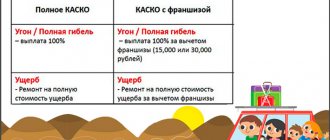What is total in CASCO insurance?
Total under CASCO is the complete or partial loss of a car due to an event covered by the insurance policy. A vehicle is considered unsuitable for restoration if more than 70% of its structural elements are damaged.
Important! The insurance amount is calculated according to the principle: for each month that has passed since the signing of the contract, a percentage of depreciation is deducted.
Total compensation will be paid if the car was damaged as a result of the event:
- fire;
- serious accident (collision with a pedestrian or obstacle, rollover, running off the road);
- natural disaster;
- unlawful actions of third parties (utility or technical services, criminals, etc.).
The extent of damage caused is determined through an independent assessment. The insurance company requests an inspection, then attaches the report to the contract.
What is included in CASCO insurance can be found here.
Total is beneficial for insurance companies because:
- after payment of compensation, the contract is terminated, and the unclaimed insurance premium remains with the company;
- the company can repair the car or sell it for parts, which will cover part of the costs;
- in some situations, an entire part of the vehicle turns out to be more expensive than was revealed during the assessment.
The driver, if in doubt about the difference, can send the insurer a request to recalculate the amount of compensation, attaching the conclusion of an independent appraiser to the case. If the company refuses to re-examine, the car owner has the right to file an application in court.
You can learn about the features of CASCO insurance for a car here.
What does this mean
Total CASCO is a term that denotes the complete or partial loss of a vehicle as a result of the occurrence of an insured event. A vehicle that cannot be fully restored is recognized as a total vehicle if it is damaged to more than 70% of the actual market value of the vehicle.
Important! The insurance value is determined very simply. For each month of validity of the contract, the insurance organization deducts the amount of depreciation from the insured amount, which was determined when concluding CASCO insurance.
In practice, a car that has received damage as a result of:
- fire;
- serious accident;
- natural Disasters;
- illegal actions of third parties.
It should be taken into account that the percentage of damage is determined by a special independent examination, which carries out an inspection only at the request of the insurance organization.
Options for paying under CASCO insurance in case of total loss of a car
Total loss of a car under CASCO is paid in three forms:
Full compensation
The insurer pays the entire amount for which the car was insured. The client signs an abandonment agreement - ownership of the vehicle is transferred to the company, for which he receives compensation. For example, if a car was insured for 1,000,000 rubles, then the owner will receive exactly that much (without any deductions). These are quite favorable terms of cooperation, but they are not so common.
Related article: Is it possible to change a windshield under CASCO and how to do it
Important! Insurers often try to take advantage of the situation: they deduct the amount of depreciation, reducing the amount of compensation, for example, to 900,000 rubles. If a similar calculation procedure is not specified in the agreement (there is no mention of deducting depreciation), then such actions are considered illegal. The driver must go to court to protect his rights.
Payments based on wear and tear
The amount of compensation taking into account wear and tear (usually equal to 1% for each month during which the policy was in force). In this case, the remains of the “lost” car also become the property of the company. For example, if the transport was insured for 1,000,000 rubles, the amount of damage was estimated at 700,000 rubles, and the accident occurred in the 12th month, then 12% (84,000) will be deducted from the compensation. The policyholder will receive 616,000 rubles.
If the incident happened closer to the time the policy was issued, and the insurer added a clause on calculating depreciation, then the client will receive the maximum benefit. The longer CASCO insurance is valid, the less money the policyholder will receive. Moreover, the company has the right to restore the “lost” car or sell it for parts, since it becomes its property. This does not happen often, since large companies try to maintain their reputation.
The client finds himself in an unpleasant situation if the car was purchased recently and on credit: compensation from the insurance company will be transferred directly to the bank. In such circumstances, it is advisable to try to keep the broken car so that you can sell the intact parts and make a profit.
Payments minus surviving parts
The company may pay compensation, from which the cost of the usable remains of the car will be excluded. Then the “lost” vehicle with all the vehicle equipment remains with the insured.
The insurer determines the amount of compensation taking into account wear and tear, subtracting the cost of serviceable remains (GOTS), which is why not much money will fall into the client’s hands, but he will retain ownership of the car. The main objective of the CASCO policy is to preserve material property at the original level will not be achieved. This form may be more profitable if the owner can sell the parts for real value. Sometimes the car can be repaired despite the appraiser's decision.
For example, a vehicle is insured for 1,000,000 rubles. The appraisers estimated the cost of the GOTS at 300,000 rubles, restoration will cost 700,000 rubles, from which depreciation is deducted (the event happened in the 12th month, which means the depreciation will be equal to 84,000 rubles). The client will be given 616,000 rubles and the remaining elements, which he can dispose of at his own discretion.
Related article: How to choose CASCO for a car and which company is better to take out a policy with
You cannot rely only on the value of the HOTS declared by the appraisers. Companies often inflate their value to save on compensation. This fact is difficult to prove, since there is no uniform regulation for accounting for HOTS in the legislation. It is easier to assess the damage to the entire vehicle and analyze proposals for the sale of vehicles with similar breakdowns.
Important! It is recommended to use the services of an independent appraiser to make the right choice. This will help to objectively assess the benefits of each option.
How the amount of payments is determined
Payments under compulsory motor liability insurance depend on the chosen insurance program and the opinion of an expert who recognizes the economic infeasibility of carrying out repairs. They are also influenced by the method of registering the total loss of the car and the actions of the insured.
The minimum threshold is set by the internal rules of the insurer and differs in a number of leading insurance companies. In most cases, this is 70-80% of the amount insured. Companies that recognize “total” at a threshold of less than 65 percent of the cost of the car are rare.
Within the prescribed period after the insurance company becomes aware of the insured event, an independent examination of the cost of the necessary repairs is appointed. Every damage and every element requiring repair is assessed. After the examination, payments will be made in the manner established by the contract and internal rules of the insurance company.
An examination is not required if the car was stolen by criminals and dismantled for parts for further sale. In this case, the conclusion of criminologists and an open criminal case will be sufficient.
After this, two situations will be possible:
- The policyholder declares abandonment of the car in favor of the insurer (concludes an abandonment agreement) and receives compensation taking into account normal wear and tear, deductible and other deductions
- The policyholder retains the car as his property, and the cost of the remaining vehicle's useful life will be added to the deductions from the sum insured.
Abandon agreement
Abandon is the refusal of the policyholder to relinquish the rights to the insured property. When it is submitted, the owner has the right to compensation for the cost of the property, taking into account existing deductions. An abandonment agreement can be concluded only in case of complete loss of the insured property.
Such an agreement can be concluded within six months from the date of the insured event. The insurer's consent is not required. The contract must specify the terms of insurance and stipulate the rights and obligations of both parties, including payment of compensation.
Insurers avoid this outcome in the event of a complete loss of the car, since in case of abandonment the amount of compensation can increase significantly. If the insurance company refuses to conclude an abandonment agreement, then you can appeal this refusal in court. Most abandonment proceedings are decided in favor of the policyholder.
Accounting for normal wear and tear
According to the Resolution of the Plenum of the Supreme Court of the Russian Federation No. 20 of June 27, 2013, when concluding an abandonment, wear and tear should not be included in the calculation of the insurance payment. However, most insurers deduct it from compensation.
Natural wear and tear in case of complete loss of the car is calculated in the same way as usual. It is taken into account on the date of the insured event. The procedure for calculating depreciation depends on the specific insurance company. It is calculated per month (up to 1-2% of the insured amount) or per year (from 12-13% of the insured amount.
Useful leftovers
This type of payment is made when the title to the car remains with the insured person. In this case, the cost of spare parts that can still be used or sold is deducted from the sum insured. Appraisers analyze inventory, identify working parts, and compare their value to the market average.
However, there are no uniform standards for calculating the HTTS, and the assessment of balances is carried out by insurance company experts. For this reason, the amount of insurance payment, compared to an abandonment, may be significantly underestimated.
How are total payments made?
The insured event must be registered in accordance with the regulations. A representative of the company issues a memo to the client, which spells out the entire algorithm of actions in case of an accident.
You need to call the traffic police to the scene of the accident and record the insured event. If you don’t have time to wait for the traffic police and collect all the accompanying documents, you can contact the emergency commissioner. Their services cost about 1,500 rubles.
In case of an accident:
- you cannot move the car from the scene of the accident;
- you need to take a photograph of the participants in the accident and record the damage;
- collect contacts of witnesses (they may be useful if proceedings arise).
What documents are needed
Payments under CASCO insurance in case of total loss of a car are assigned upon provision of documents:
- identification;
- confirmation of ownership (PTS, STS, etc.);
- driver license;
- a copy of the insurance policy;
- certificate from the traffic police (official proof of the occurrence of an insured event).
Important! The policyholder additionally fills out an application form - it is issued at the company’s office.
What to do with valid CASCO balances
You can try to sell the usable remains on the open market, make a profit, add compensation from the insurer and buy a new car. The sale of parts can begin only after receiving the appraiser's report and documentary agreement with the company.
Important! If, according to the expert’s assessment, the cost of the HOTS is too low, then it is more profitable to leave the parts to the insurer and receive compensation. The possibility of choosing the form of payment is provided for in Article 10, Clause 5 of the Law “On the Organization of Insurance Business”.
You cannot sell GOTS if a trial is planned (for example, the client does not agree with the decision or the insurer is delaying the transfer of compensation). Re-evaluation may be required. If GOTS are not available, then the court will be able to rely only on a previously conducted examination.
If suitable parts are transferred to the insurer, the client is obliged to ensure their safety. The policyholder, as the owner of the car, bears full responsibility for it. If the HOTS receive additional damage, the company may refuse to accept it and pay compensation.
Related article: The main type of CASCO sample in different insurance companies
Damaged vehicles are sent to paid parking. The insurer undertakes to pay the client's expenses necessary to transfer the car into the ownership of the company, unless otherwise provided by the contract. In practice, the insurance company is in no hurry to take on expenses. The client must notify the company that, in order to preserve the property, the car was placed in a paid parking lot, and attach a copy of the invoice for services. If the insurer’s manager offers to bring the vehicle to the office, this cannot be done, since then the owner will have to pick it up at his own expense. Additional costs can only be challenged in court.
Important! The car ceases to be the property of the driver at the moment of signing the abandonment agreement. From now on, you can stop paying for parking if the policyholder paid for it.
How are payments made if the car is a credit car?
The following procedure applies to credit cars:
- The insurance company notifies the lender about the accident, since according to the contract, compensation is due to him, and not to the driver.
- The client fills out an application for payment, in which he indicates information about himself and the vehicle, and attaches an expert report.
- The insurance company sends a response to the policyholder and transfers money to the creditor. Part of the funds may be transferred to the borrower if the insurance amount exceeds the remaining debt. For example, if the loan was repaid ahead of schedule and was repaid by 80%, then the bank may allow all the money to be sent to the policyholder’s account.
With a total credit car, the driver loses part of the profit, but reduces the amount of debt to the bank.
Payment options
Again, everything here also depends on the specific insurance company. After all, there are organizations that stipulate in the contract the possibility of assessing the loss of a car only by certain expert organizations. Is it necessary to clarify that these expert organizations in this case are appointed only by the insurance company itself and may not be very conscientious, or act at the direction of insurance agents.
Then you will have to defend your rights for a long time and difficultly in court.
In terms of payment, several options may be offered:
- The insurer pays the full amount of compensation to the car owner and takes the car with undamaged spare parts and body parts for itself (by agreement).
- The insurer pays the amount of compensation, but deducts from this money those suitable spare parts that the car owner wished to keep for himself. Naturally, an expert assessment of the cost of these spare parts is carried out, taking into account the wear and tear recorded at the time of the transaction.
- Some insurance companies immediately suggest using the second point, but at the same time they advise their partners who sell cars for spare parts. In this case, compensation is also paid minus the parts sold.
Which option to choose and which to immediately refuse should be decided in each individual case independently. That is why it is important to understand what the insurance company has the right to do, and what its actions are outside the legal field.
For example, unreliable insurance companies can easily impose their services on the sale of entire spare parts or the sale of a damaged vehicle without disassembly. In this case, you need to remain careful in any case, since it is unknown who will be involved in the sale, what kind of relationship the insurance company has with these people or organization, whether they have the opportunity to underestimate payments and the cost of selling usable parts of the property in their favor.
It is also obvious that, in general, “total” payments under CASCO are almost always quite large. Naturally, this is fertile ground for all kinds of fraud and money laundering. This means that it is important to select in advance the most reputable insurance company with an impeccable reputation and extensive experience in the market.
Some of the key indicators of an insurer's reliability are: a transparent contract, only non-cash forms of payment for CASCO, a minimum of attempts to impose its services in the event of an insured event.
When you won't be able to get a refund
The insurance company has the right to refuse to pay compensation if the accident occurred due to the malicious intent of the owner or due to a vehicle malfunction.
For example, the policyholder will not receive money if a fire occurs due to a short circuit in the wiring. Also, compensation will not be paid if the driver was under the influence of alcohol or drugs.
Important! If the policyholder does not agree with the decision of the insurance company, he has the right to go to court. He will have to collect evidence of his innocence, otherwise the judge will side with the company.
Pitfalls of CASCO payments in case of total loss of a car
Litigation is the norm in the insurance industry. The limit of surviving elements of the car, required for recognition of the total, can play into the hands of the policyholder. If this point is not clearly stated in the contract, then it is permissible to use a comparative analysis of the conditions of other companies. In court, constructive loss of a car under CASCO can be recognized even with 50% of the damage.
Most often, insurance companies are willing to pay compensation only taking into account wear and tear. The owner needs to consider the age of the vehicle when deciding whether to keep the vehicle. If, due to the long service life, depreciation has accumulated, then it makes sense to sell off the HOTS yourself.
Total loss of a credit car under CASCO
Separately, it is worth mentioning the total loss of a credit car under CASCO. The main nuance here is that the beneficiary in this case is not the driver, but the bank. Moreover, this payment goes towards repaying the loan. The rest of the amount is transferred by the bank to the driver’s account. In this case, the loan agreement is terminated, but the driver is left without a car.
Often, the total loss of a credit car under CASCO is doubly disadvantageous for car owners. Imagine a situation where he paid the loan for a certain time, and then was left without a car and with an amount that is hardly enough for the down payment on a new loan, which will have to be paid again. However, even this is many times better than being left not only without a car, but also without any compensation, with a huge debt to the bank. And this is exactly what awaits those who take risks and look for all sorts of ways to avoid paying CASCO for the second year of the loan.







